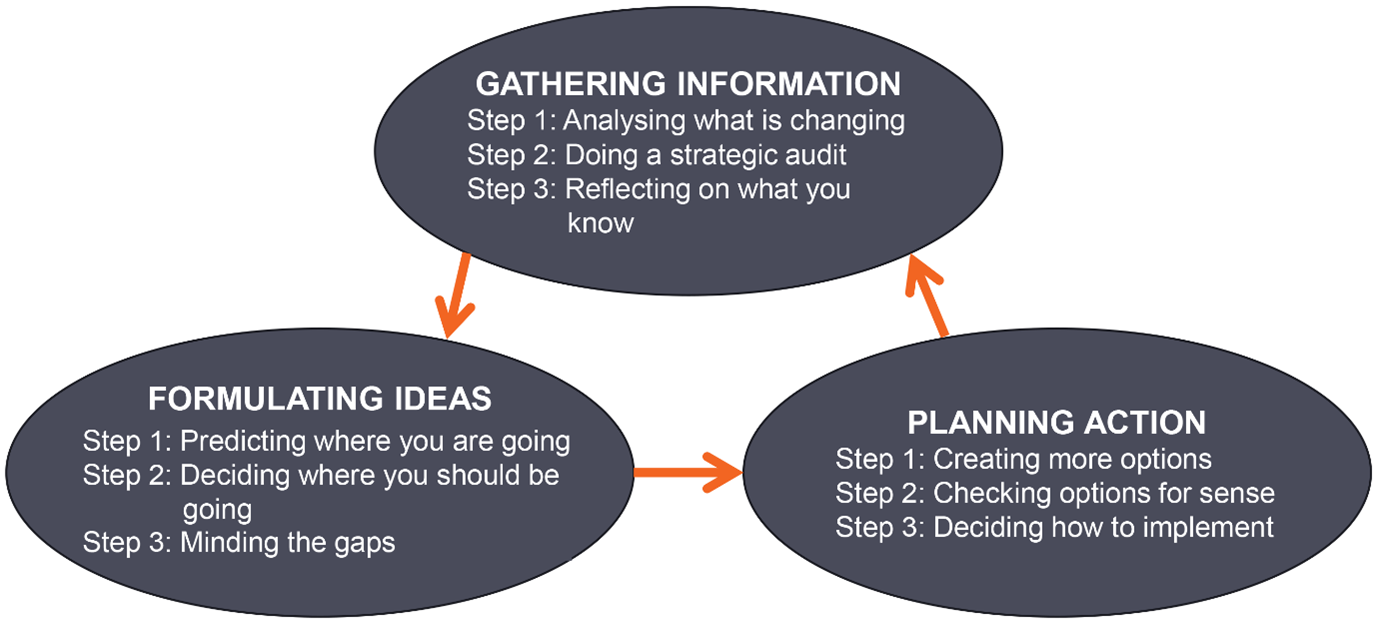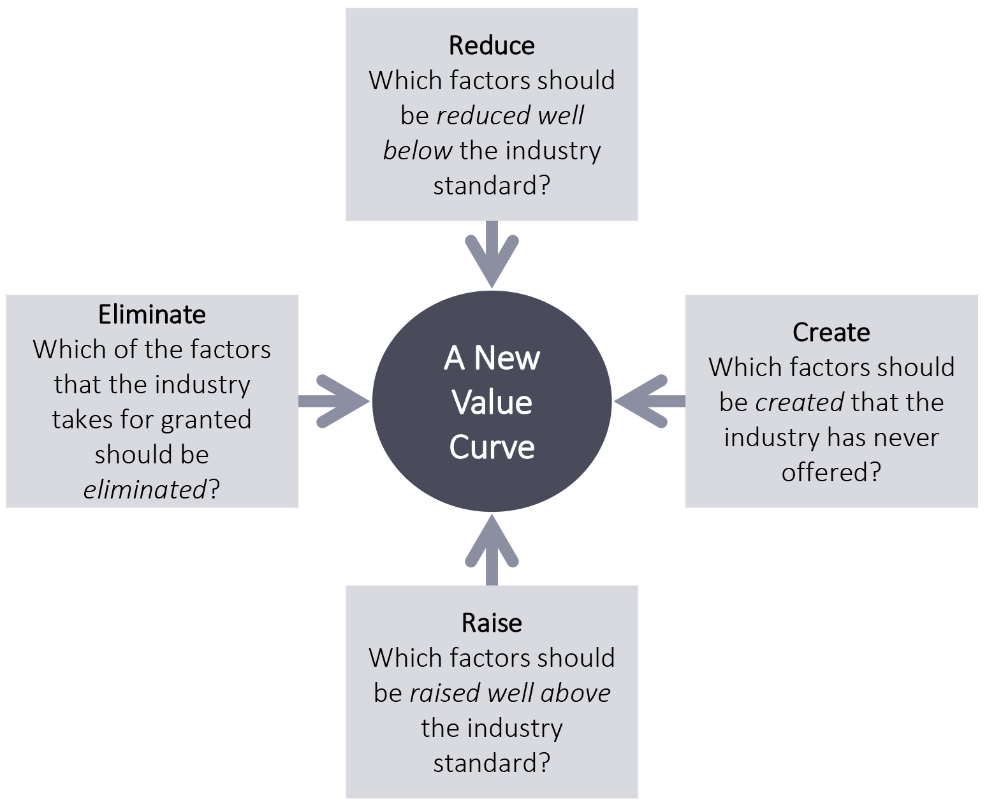Strategy tools to promote strategic thinking
Board members are now encouraged to ‘think strategically’. Indeed, it is now considered that a board’s role is to think strategically and oversee strategic planning. We discussed strategic thinking versus strategic planning in Part two of this series of articles - Why a three-year strategic plan for your school just isn’t enough.
In this article, Effective Governance Senior Advisor Ian Doyle discusses strategic thinking in more detail and looks at some of the tools you can use to promote strategic thinking.
Strategic thinking focuses on finding and developing unique opportunities to create value by enabling a provocative and creative dialogue among people who can affect your school’s direction, i.e., the board and principal/management team. It is the input to strategic planning. Good strategic thinking uncovers potential opportunities for creating value and challenges assumptions about a school’s value proposition (i.e., the benefits students and families can expect from attending the school), so that when the strategic plan is created, it targets these opportunities.
Strategic thinking is a way of understanding the fundamental drivers of a business and challenging conventional thinking about them, in discussion with others. Finally, strategic thinking is having an awareness of what has not yet taken shape, having foresight. Therefore, boards should encourage forward thinking, remembering that what served the school well at one time may not ensure its success in the future.
As Bell notes:
The essential purpose of strategic planning is to scan the environment in which the school operates, forecast the future for the school and then deploy resources in order to meet the predicted situation ... Thus, strategic planning in schools, if it is to succeed, must be based on an analysis of both the present situation and possible future states.
It can be difficult to be strategic. But a strategic thinker is always searching for the unusual, something that is different and is able to set assumptions aside. They intentionally look at things from different perspectives and can resist the urge to let one decision dictate or forecast future decisions, thus avoiding the sunk cost ‘effect’ or ‘fallacy’. A person who has strategic perspective creates clarity out of complex and seemingly disconnected details. They can sense a change in the wind, detect points of conflict and opportunity and articulate in concrete and compelling terms how they can be addressed. They get to the heart of a problem and see the relationship between key elements. Table 1 sets out the characteristics of strategic versus non-strategic thinking.
Table 1: Strategic vs. non-strategic thinking
Strategic |
Non-Strategic |
|
Broad view with zoom in |
Narrow view |
|
Abstract with powerful engagement of the imagination |
Concrete with no engagement of the imagination |
|
Abstraction illustrated with concrete examples |
Concrete illustration only |
|
Important, non-intuitive, framework breaking ideas |
Generally understood ideas that fit within a consensus framework |
| Embraces alternatives and uncertainties | Embraces neither alternatives nor uncertainties |
| Aims to achieve an over-arching goal | Focuses on supporting goals |
Source: Keelin & Arnold, 2002, ‘Five Habits of Highly Strategic Thinkers’
When engaging in strategic thinking, there are four critical questions that should be asked by the board and senior management.
1. What is the economic environment in which we must operate?
Organisations must constantly scan the environment for weak signals rather than simply conducting periodic analyses of the business landscape. Changes in one industry or segment often affect organisations in others. For example, who could have imagined that changes brought about by the computer industry and the internet would affect the music industry so radically. Currently, artificial intelligence (AI) is set to transform every industry and sector including the education sector.
2. What competencies does the organisation have which provide a sustainable competitive advantage?
This question focuses on understanding the relative strengths and weaknesses of the organisation including its human capital, technologies, finances, work processes, etc.
3. What resources support or constrain our actions?
Understanding the organisation’s resource base – such as financial, physical and time – is also a critical element of strategic thinking.
4. What opportunities lay before us?
This question relates to understanding the opportunities available for the organisation to pursue along with consideration of the risks associated with different opportunities and potential courses of action. Having completed strategic thinking, decisions now need to be made.
Beyond these questions, strategic thinkers will also consider:
- What profound shifts are, or will, influence the future?
- What is our direction and response to these shifts?
- How will we describe our desired results in measurable terms?
- What are the best ways and means to get there?
- How will we measure progress and success?
- How will we revise as required?
Wootton and Horne (2001) see strategic thinking as involving three main activities, as shown in Figure 1.
Figure 1: Strategic Thinking Framework

Source: Wootton & Horne, 2001, Strategic Thinking
What is the Blue Ocean Strategy?
The board’s role in strategic thinking is to bring an outside perspective and accumulated wisdom and to test the consistency of management’s thinking, while the role of senior management is to initiate the process of strategic thinking and set the agenda by posing the questions and issues. A couple of tools to assist with strategic thinking include Blue Ocean Strategy and scenario planning.
Blue Ocean Strategy is the simultaneous pursuit of differentiation and low costs with the aim being not to out-perform the competition in the existing industry, but to create new market space or a ‘blue ocean’, thereby making the competition irrelevant. For a school, this might involve finding an untapped source of new enrolments and revenue. Blue Ocean Strategy provides a set of tools to create new market space. It offers a way to swim out of the red ocean filled with sharks!
One of the best-known Blue Ocean Strategy tools is the Four Actions Framework, which focuses on creating an organisation’s strategic profile and value curve by creating, eliminating, reducing, or raising industry factors (Figure 2). Answering the questions in this framework will give insights as to what your school’s new strategy should look like:
- Which factors that the industry has long competed on should be eliminated?
- Which factors should be reduced well below the industry’s standard?
- Which factors should be raised well above the industry’s standard?
- Which factors should be created that the industry has never offered?
The other key tool is the Strategy Canvas, which is the central diagnostic for building a compelling Blue Ocean Strategy. Blue Ocean Strategy covers both strategy formulation and strategy execution.
Figure 2: Four actions framework

Source: Kim & Mauborgne, 2005, Blue Ocean Strategy
Scenario planning
Scenario planning can play a meaningful role in strategic thinking due to its focus on the future. Scenario planning explores possible futures based on forecast changes to the competitive environment – what will the organisation look like in 10 or 20 years’ time? It provides a disciplined means to imagine potential futures that companies have applied to a variety of issues. Scenario planning also plays a useful role in simplifying data into a small range of possible states. Each scenario explains how different elements may interact given certain conditions. Scenarios also support creative thinking in the context of time. While it cannot enable you to predict the future, it does produce alternative views of the school’s future that allow you to plan within a range of possibilities.
There are, of course, many other tools available to boards to promote strategic thinking such as Hambrick and Fredrickson’s ‘Integrated Choices’ framework. The choice is up to the individual board. What is important is that the board recognise the need to think strategically, since it is key to the board making a meaningfully contribution to the school’s strategy.
Finally, because strategic thinking is a competency needed by all board members, it is important to evaluate whether all directors have this skill. If not, it is crucial that the board receive some training in this area. Strategy workshops facilitated by someone experienced in strategic planning at the board level can be of particular benefit in developing this vital competency. It is also imperative to remember to look for the ability to think strategically when recruiting new board members.
If you would like to discuss strategic planning at your school or have any other questions, please contact our team for more information.
